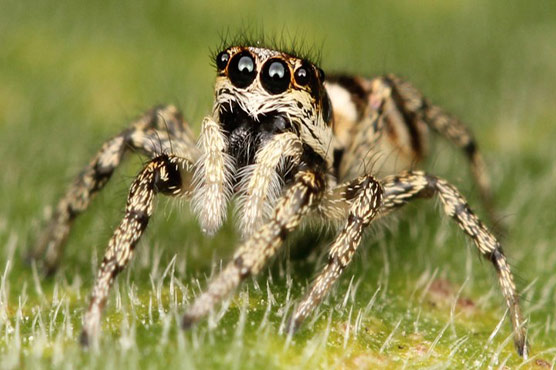Climate change may make spiders angry: study

Scientists are also predicting an increase in what are called "black swan" weather events.
(Web Desk) – A dramatically changing climate is going to have a lot of negative side effects we didn’t predict, and scientists have just found a new one: really cranky spiders.
A heating climate may or may not increase the frequency of tropical storms, but it probably will make them more intense.
Scientists are also predicting an increase in what are called "black swan" weather events, so named because they are unprecedented in their ferocity.
And it turns out that when it comes to some social spiders, the more aggressive ones are the ones likely to survive tempestuous weather, and therefore pass on their traits to new generations.
"It is tremendously important to understand the environmental impacts of these ‘black swan’ weather events on evolution and natural selection," said evolutionary biologist Jonathan Pruitt, of McMaster University.
"As sea levels rise, the incidence of tropical storms will only increase. Now more than ever we need to contend with what the ecological and evolutionary impacts of these storms will be for non-human animals."
The particular spider pudding in which this proof can be found is an arachnid called Anelosimus studiosus. They live across North and South America - including the Gulf and East Coasts, which are wracked by tropical cyclones between May and November that come in from the Atlantic Ocean.
Typically, these spiders live in colonies in three-dimensional tangle webs. Up to a few hundred females can live in these webs, overhanging bodies of water such as rivers and lakes.
But they’re not all happy little spiders peacefully sharing the same space. The species displays two distinct behavioural phenotypes. Some of the spiders are more tolerant and relatively placid, while others are more aggressive. These can live side-by-side in the same colony; the more aggressive spiders in the colony, the more aggressive overall the colony is.
And this aggression is heritable.
More aggressive spiders are faster to respond to both predators and prey - but they’re also more likely to attack their own kind, and cannibalise their own eggs and the males of the species. So they’re better at fending for themselves when trouble hits the fan.
"Colony aggressiveness in A. studiosus is transmitted down colony generations from parent to daughter colony, and is a major determinant of spiders’ survival and fecundity in habitat- and site-specific manners," the researchers wrote in their paper.
"More broadly, aggressiveness in spiders is correlated with habitat resources, which also fluctuate in response to tropical cyclones."
To determine the effect these storms were having on spider aggression, the researchers waited until a storm’s landfall path was predicted, then sampled spider colonies in that location. Then they returned to the site within 48 hours of the storm’s passing, and sampled the colonies again.
They also recorded the number of egg cases in each colony, and the survival rate of the spiderlings. Overall, the team chose three major cyclones in 2018 and sampled 240 colonies in total; they looked at sites impacted by the storms along with paired control sites, not located in the path of storms.
Survival rate for the initial cyclone strike was actually pretty high - 75.42 percent of colonies made it through. Overall, and longer term, the number of egg cases produced fell, as did the survival rate of the spiderlings. But this wasn’t evenly distributed between aggressive and placid colonies.
"Tropical cyclones selected for more aggressive colony phenotypes. Following tropical cyclones, colonies with more aggressive foraging responses produced more egg cases and had more spiderlings survive into early winter, whereas the opposite trend emerged in control sites," the researchers wrote.
"This trend is consistent across multiple storms that varied in both size, duration and intensity. This shows that these effects are not idiosyncratic but are robust evolutionary responses that hold across storms and at sites occupying a spread of 5 degree latitude."
The reason why this is the case isn’t immediately clear, but a decrease in food resources immediately after the storm could have something to do with it. And competitor spider species could be more aggressive, too - requiring more aggressive individuals to protect the colony from invaders.
Finally, the researchers note, mother spiders may be too busy trying to find food and protect their resources to invest time in maternal care, forcing their young to develop hardcore survival skills.
So, in a way, humans could well be creating an angry spiderpocalypse. We brought this on our own heads.
The paper has been published in Nature.

